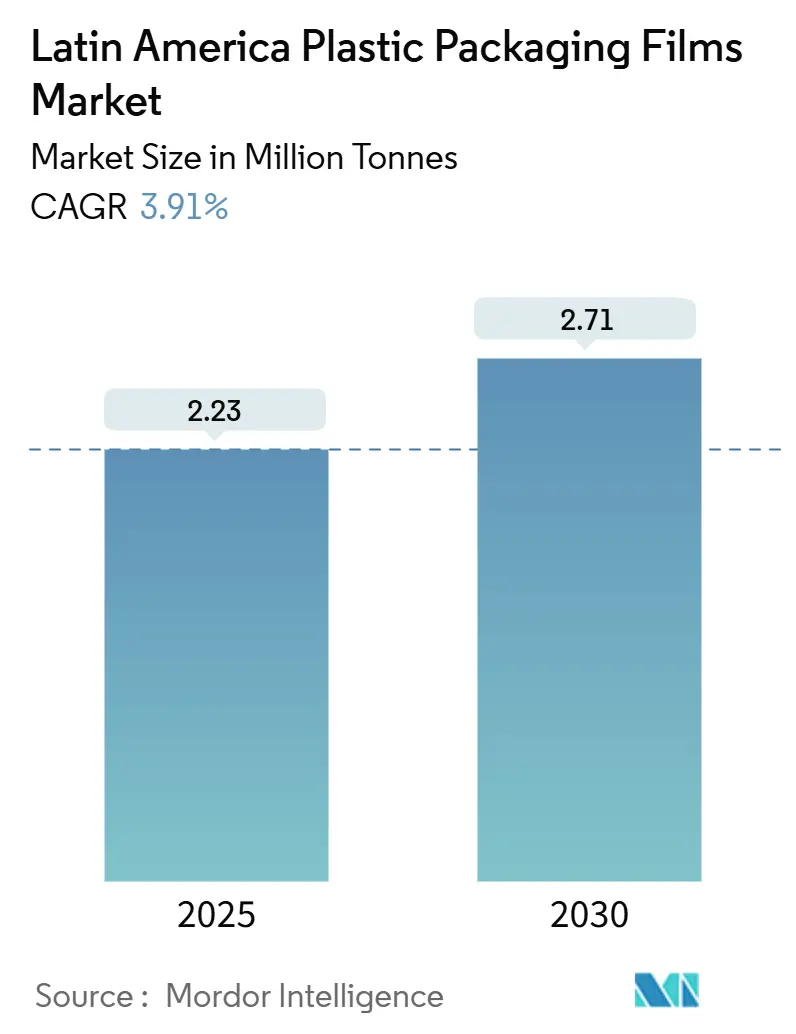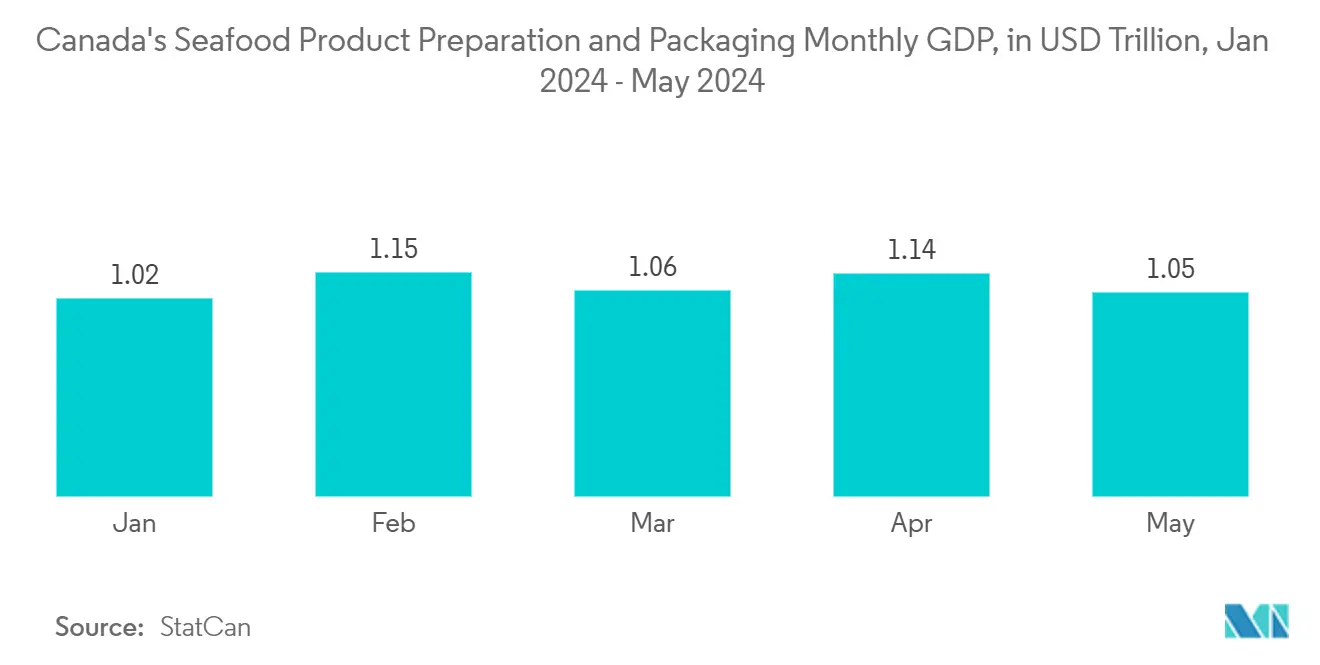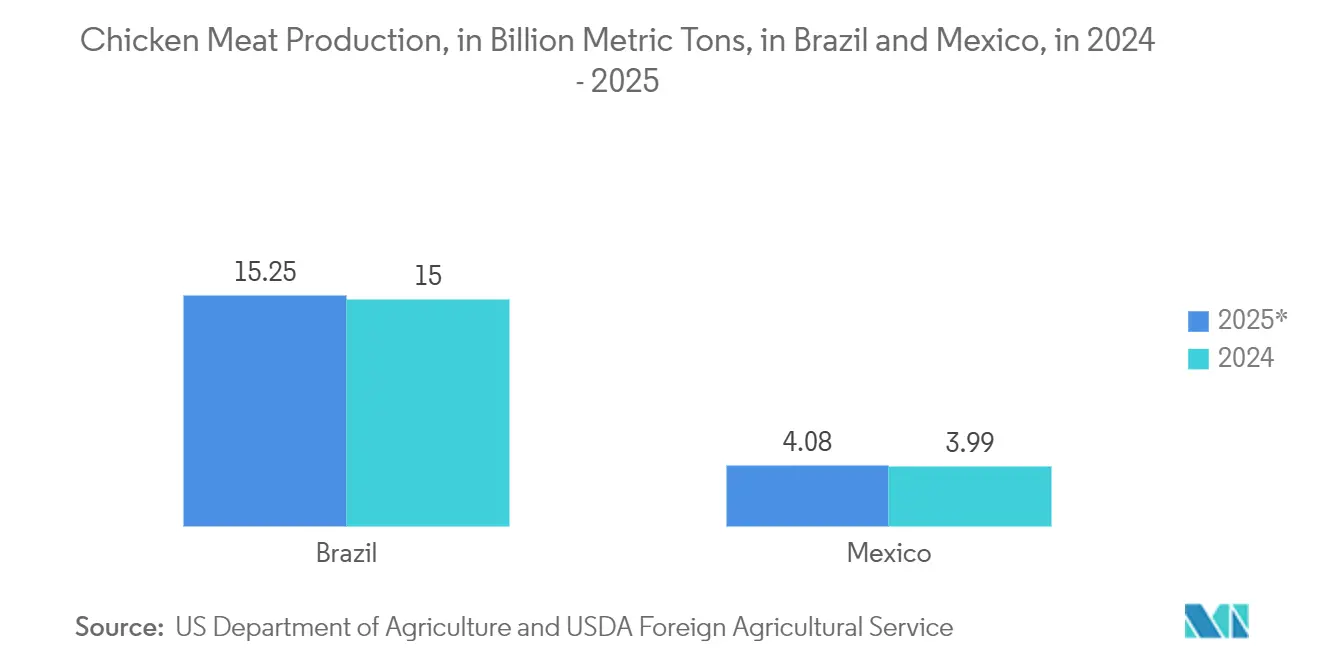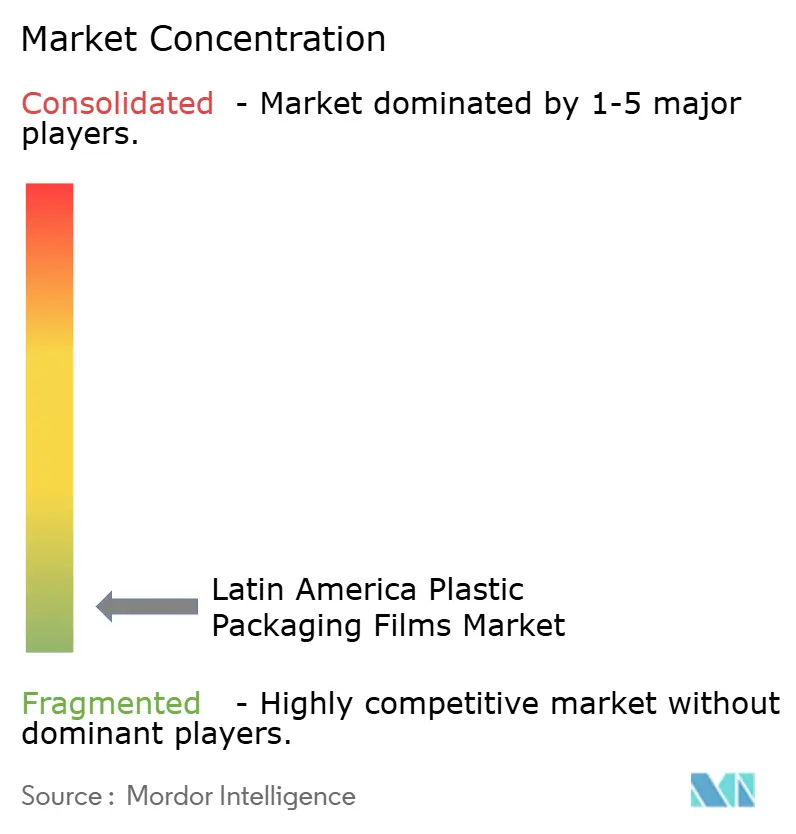Latin America Plastic Packaging Films Market Size and Share

Latin America Plastic Packaging Films Market Analysis by Mordor Intelligence
The Latin America Plastic Packaging Films Market size is estimated at 2.23 Million tonnes in 2025, and is expected to reach 2.71 Million tonnes by 2030, at a CAGR of 3.91% during the forecast period (2025-2030).
- Several factors drive the plastic packaging film market in Latin America, and the increasing demand for convenient and lightweight packaging solutions is a key driver, as consumers in the region seek easy packaging to handle, store, and transport. Plastic films offer these benefits, making them popular for various products.
- Rising consumer awareness of sustainability is another significant factor influencing the market. As environmental concerns grow, there is a shift towards more eco-friendly packaging options. This has led to the development of recyclable and biodegradable plastic films to meet consumer expectations.
- Additionally, advancements in packaging technology for improved shelf life and product protection have contributed to market growth. Innovations in plastic film manufacturing have resulted in materials that better preserve food and other perishable items, reducing waste and extending product longevity. These factors collectively drive the expansion and evolution of Latin America's plastic packaging film market.
- The versatility of plastic film packaging in accommodating various shapes and sizes, its cost-effectiveness, and ease of transportation further contribute to its growth. As industries prioritize eco-friendly solutions and consumers seek convenience and functionality, the flexible packaging market is poised to expand.
- Higher retail sales often lead to market expansion, with new products entering the market and existing ones reaching broader audiences. Plastic film is adaptable to different product categories, making it suitable for various industries, including food and beverage, pharmaceuticals, personal care, and more. Thus, expanding retail sales could drive growth in multiple segments of the plastic film packaging market.
- Further, the versatility of plastic film packaging in accommodating various shapes and sizes, its cost-effectiveness, and ease of transportation contribute to its growth. As industries prioritize eco-friendly solutions and consumers seek convenience and functionality, the flexible packaging market is poised to expand.
- Higher retail sales often lead to market expansion, with new products entering the market and existing ones reaching broader audiences. Plastic film is adaptable to different product categories, making it suitable for various industries, including food and beverage, pharmaceuticals, personal care, and more. Thus, expanding retail sales could drive growth in multiple segments of the plastic film packaging market.
- Government bans on single-use plastics and regulations on plastic packaging have limited the market for plastic packaging films. These restrictions have been implemented in various countries and regions to address environmental concerns and reduce plastic waste. As a result, manufacturers and businesses in the packaging industry have had to adapt their strategies and product offerings. However, these regulatory changes have also created new opportunities within the packaging sector.
- The demand for recyclable and sustainable packaging solutions has increased significantly as companies seek alternatives to traditional plastic packaging. This shift has led to innovations in materials and designs, focusing on eco-friendly options that meet regulatory requirements and consumer preferences. Consequently, while the market for conventional plastic packaging films may have faced challenges, the overall packaging industry has seen growth in sustainable alternatives, driving research and development in recyclable materials and environmentally conscious packaging solutions.
- Consumers in the region are increasingly favoring packaging materials with environmentally friendly properties. Recyclable materials have seen high adoption rates due to their eco-friendly nature and recyclability. Governments regionally have responded to public concerns about packaging waste, particularly plastic, by introducing regulations to minimize environmental impact and improve waste management processes.
- In November 2023, Plastrela, a Brazil-based converter, developed a snack-size PET standup pouch for Adimax. This pouch is more easily recycled than conventional PET/PE SUP structures. The new design replaces the traditional multilayer PET substrate and polyethylene (PE) sealant with a mono-material PE packaging, which is easier to recycle.
Latin America Plastic Packaging Films Market Trends and Insights
Polyethylene Segment to Hold Significant Market Share
- Polyethylene is primarily used for packaging applications such as plastic bags, films, and geomembranes. It is a lightweight, partially crystalline, thermoplastic resin with high chemical resistance, low moisture absorption, and sound-insulating properties. Low-density polyethylene (LDPE) is commonly used in manufacturing plastic bags. LDPE bags are soft and flexible and maintain these properties even at low temperatures. They are available in natural colors and are in demand due to their flexibility, transparency, high-impact strength, and weak barrier properties (except for water and alcohol vapor). While these bags have low-temperature resistance, they possess excellent electrical properties and chemical resistance. However, they are prone to environmental stress cracking.
- LDPE is preferred for film packaging and electrical insulation due to its flexibility. It is commonly used in packaging films, trash and grocery bags, agricultural mulch, and wire and cable insulation. LDPE has a lower density than HDPE because of its reduced crystallinity, resulting in a softer and more flexible material. However, this slightly diminishes its barrier properties. LDPE's lower density and increased flexibility make it ideal for applications where malleability is crucial, such as in producing squeezable bottles or manufacturing thin, pliable films. Despite its reduced barrier capabilities compared to HDPE, LDPE offers sufficient protection for many products, making it a versatile choice in various packaging and insulation applications.
- • Polyethylene is primarily used for packaging plastics. In 2023, the gross production value of Brazil's packaging sector reached an estimated USD 28.91 billion, of which nearly USD 9.59 billion corresponded to plastic packaging. This indicates a growing market for plastic film packaging in Brazil. The significant portion of plastic packaging within the overall packaging sector highlights the importance of polyethylene-based products in the Brazilian market. As consumer demand for packaged goods continues to rise, the plastic film packaging industry is likely to experience further growth. This trend is driven by urbanization, changing consumer lifestyles, and the need for convenient, lightweight packaging solutions across the industries of food and beverage, personal care, and household products.
- LDPE is widely used in flexible packaging due to its good chemical and oil resistance and low cost. Unlike HDPE, LDPE has a hazy appearance but is clearer. It has a lower melting temperature, which can be a disadvantage when heat stability is required but is advantageous when low-temperature melting is needed. LLDPE, another common packaging film, is characterized by its low density and the presence of comonomers that create branch-like structures on the main chain, reducing crystallinity. This results in a hazy appearance and a malleable texture. Compared to LDPE, which has the same density and thickness, LLDPE exhibits superior impact strength, tensile strength, puncture resistance, and elongation.

Frozen Food Segment Expected to Hold Significant Share in the Market
- Frozen food categories often drive innovation in plastic film packaging design to meet specific requirements such as maintaining freshness, ease of use, and shelf appeal. Manufacturers invest in developing new types of plastic film packaging tailored to frozen food needs, stimulating growth in the plastic film packaging market. These innovations address the unique challenges posed by frozen foods, including protection against freezer burn, moisture control, and the ability to withstand temperature fluctuations during storage and transportation.
- As consumers demand more convenient and high-quality frozen food options, packaging manufacturers continue to refine their plastic film solutions, incorporating features like resealable closures, easy-open designs, and improved barrier properties. This ongoing development enhances the functionality of frozen food packaging. It contributes to the overall expansion of the plastic film packaging market, as these advancements often find applications in other food and non-food sectors.
- In 2025, Mexico's chicken meat production will reach 4.08 million metric tons. This growth trend indicates rising chicken meat consumption and increased demand for plastic film in packaging meat products and frozen foods. The consistent increase in chicken meat production reflects changing consumer preferences and dietary habits in Mexico. Plastic film is crucial in preserving the quality and extending the shelf life of fresh and frozen chicken products. This correlation between chicken meat production and packaging needs highlights the interconnected nature of the food production and packaging industries, emphasizing the importance of efficient and effective packaging solutions in the meat sector.
- According to the United States Department of Agriculture, Brazil's food industry has experienced consistent growth, with over 94,706 hypermarkets nationwide contributing to this expansion in physical and digital formats. The sector in Brazil is well-integrated, dynamic, and sophisticated, making it an attractive market for Western companies to make strategic investments. These investments often focus on increasing production capacity and innovating plastic film packaging products to meet the specific needs of the Brazilian market. Furthermore, Brazil's rapidly growing e-commerce sector is expected to increase demand for plastic film packaging solutions for food packages, such as pouches and films. This trend presents several potential market opportunities for flexible packaging, including innovation, sustainability, and increased competition.

Competitive Landscape
The Latin America Plastic Packaging Films Market is fragmented, with several global and regional players, such as Berry Global Inc., FLEX AMERICAS SA de CV, Innovia Films (CCL Industries Inc.), Taghleef Industries Group, and others, vying for attention in a contested market space. The market has been characterized by low product differentiation, growing levels of product penetration, and high levels of competition.
Latin America Plastic Packaging Films Industry Leaders
-
Berry Global Inc.
-
FLEX AMERICAS S.A. de C.V.
-
Innovia Films (CCL Industries Inc.)
-
Taghleef Industries Group
-
Poly Rafia, S.A. De C.V.
- *Disclaimer: Major Players sorted in no particular order

Recent Industry Developments
- October 2024: Tredegar Surface Protection, a subsidiary of Tredegar Corporation (NYSE:TG) and a leader in high-quality masking films, proudly unveils its latest innovation: the Optennia packaging film. Now accessible via our broad distribution network, Optennia promises enhanced protection and performance, all while championing sustainability.
- July 2024: Innovia Films, a BOPP film manufacturer, introduced a new white 'ultra-low density' film designed for ice cream flow wrap packaging. The company reports that the films are minimally affected by climate conditions but should be stored below 104°F (40°C). Innovia states that the film can be maintained for up to 6 months without degradation under appropriate storage conditions.
Latin America Plastic Packaging Films Market Report Scope
Plastic film packaging is a flexible solution made from different plastic materials, depending on the end-user requirements. The study tracks the demand for converted packaging films across the primary resin and end-user industry applications. The report analyzes the factors that impact geopolitical developments in the market studied based on the prevalent base scenarios, key themes, and end-user industries-related demand cycles. Analysis of the market is based on the market insights that were captured through secondary research and the primaries. Furthermore, the market covers the major factors impacting the plastic film packaging market’s growth in terms of drivers and restraints. The estimates exclude the weight and the cost of the content that is or is to be packed inside the plastic film packaging. The scope of the study is limited to B2B demand.
The Latin America plastic packaging films market is segmented by type (polypropylene (biaxially oriented polypropylene (BOPP), cast polypropylene (CPP)), polyethylene (low-density polyethylene (LDPE), linear low-density polyethylene (LLDPE)), polyethylene terephthalate (biaxially oriented polyethylene terephthalate (BOPET)), polystyrene, bio-based, PVC, EVOH, PETG, and other film types), by end-user industry (food [candy and confectionery, frozen foods, fresh produce, dairy products, dry foods, meat, poultry, and seafood, pet food, and other food products (seasonings and spices, spreadable, sauces, condiments, etc.)], healthcare, personal care and home care, industrial packaging, other end-user industry applications) by country (Brazil, Mexico, Columbia, Rest of Latin America). The report offers market forecasts and size in volume (tonnes) for all the above segments.
| Polypropylene[PP] (Biaxially Oriented Polypropylene [BOPP],Cast polypropylene[ CPP]) |
| Polyethylene (Low-Density Polyethylene [LDPE], Linear low-density polyethylene [LLDPE]) |
| Polyethylene Terephthalate (Biaxially Oriented Polyethylene Terephthalate [BOPET]) |
| Polystyrene |
| Bio-based |
| Polyvinyl Chloride, Ethylene Vinyl Alcohol, and Other Film Types |
| Food | Candy & Confectionery |
| Frozen Foods | |
| Fresh Produce | |
| Dairy Products | |
| Dry Foods | |
| Meat, Poultry, and Seafood | |
| Pet Food | |
| Other Food Products (Seasonings & Spices, Spreadables, Sauces, Condiments, etc.) | |
| Healthcare | |
| Personal Care & Home Care | |
| Industrial Packaging | |
| Other End-use Industry Applications (Agricultural, Chemical, Etc) |
| Brazil |
| Mexico |
| Columbia |
| By Type | Polypropylene[PP] (Biaxially Oriented Polypropylene [BOPP],Cast polypropylene[ CPP]) | |
| Polyethylene (Low-Density Polyethylene [LDPE], Linear low-density polyethylene [LLDPE]) | ||
| Polyethylene Terephthalate (Biaxially Oriented Polyethylene Terephthalate [BOPET]) | ||
| Polystyrene | ||
| Bio-based | ||
| Polyvinyl Chloride, Ethylene Vinyl Alcohol, and Other Film Types | ||
| By End-User Industry | Food | Candy & Confectionery |
| Frozen Foods | ||
| Fresh Produce | ||
| Dairy Products | ||
| Dry Foods | ||
| Meat, Poultry, and Seafood | ||
| Pet Food | ||
| Other Food Products (Seasonings & Spices, Spreadables, Sauces, Condiments, etc.) | ||
| Healthcare | ||
| Personal Care & Home Care | ||
| Industrial Packaging | ||
| Other End-use Industry Applications (Agricultural, Chemical, Etc) | ||
| By Country | Brazil | |
| Mexico | ||
| Columbia | ||
Key Questions Answered in the Report
How big is the Latin America Plastic Packaging Films Market?
The Latin America Plastic Packaging Films Market size is expected to reach 2.23 million tonnes in 2025 and grow at a CAGR of 3.91% to reach 2.71 million tonnes by 2030.
What is the current Latin America Plastic Packaging Films Market size?
In 2025, the Latin America Plastic Packaging Films Market size is expected to reach 2.23 million tonnes.
Who are the key players in Latin America Plastic Packaging Films Market?
Berry Global Inc., FLEX AMERICAS S.A. de C.V., Innovia Films (CCL Industries Inc.), Taghleef Industries Group and Poly Rafia, S.A. De C.V. are the major companies operating in the Latin America Plastic Packaging Films Market.
What years does this Latin America Plastic Packaging Films Market cover, and what was the market size in 2024?
In 2024, the Latin America Plastic Packaging Films Market size was estimated at 2.14 million tonnes. The report covers the Latin America Plastic Packaging Films Market historical market size for years: 2020, 2021, 2022, 2023 and 2024. The report also forecasts the Latin America Plastic Packaging Films Market size for years: 2025, 2026, 2027, 2028, 2029 and 2030.
Page last updated on:
Latin America Plastic Packaging Films Market Report
Statistics for the 2025 Latin America Plastic Packaging Films market share, size and revenue growth rate, created by Mordor Intelligence™ Industry Reports. Latin America Plastic Packaging Films analysis includes a market forecast outlook for 2025 to 2030 and historical overview. Get a sample of this industry analysis as a free report PDF download.
.webp)


